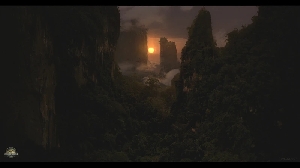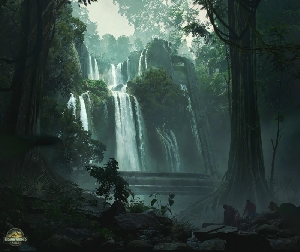Huge Little Known Theropods
Dinosaurs Forum Topic

Makaveli7
MemberCompsognathusMay 16, 20132857 Views5 Replies Everybody knows about Tyrannosaurus Rex, 90% of dinosaur fans know about Spinosaurus, 85% know about Giganotosaurus, and 80% know about Carcharodontosaurus. All of these theropods were 40+ feet. But there are other theropods that are nearly the same size. The dinosaurs I will list here are all approaching or past the 40 foot mark. In no particular order, I will list these titans below.
Mapusaurus
[img]http://images3.wikia.nocookie.net/__cb20110808170560/dinosaurs/images/4/4f/Mapusaurus_BW.jpg[/img]
A close relative of Giganotosaurus, fossils suggest that this dinosaur hunted in packs. Though smaller than it's relative, it was still quite a large theropod at nearly 40 feet. A number of specimens were found in close proximity to each other, suggesting pack hunting. As a pack, these dinosaurs would have been able to take out large herbivores like Argentinosaurus, one of the largest sauropods known.
Tyrannotitan
[img]http://0.tqn.com/d/dinosaurs/1/0/q/4/-/-/tyrannotitan.jpg[/img]
Another relative of Giganotosaurus, Tyrannotitan's image was equally as awesome as its name. At about 40 feet, this Titan was certainly a force to be reckoned with. Speedy and powerful, Tyrannotitan was possibly one of the greatest predators of all time.
Saurophaganax
[img]http://pnf-primeval.wikispaces.com/file/view/Saurophaganax%205.gif/393422358/450x323/Saurophaganax%205.gif[/img]
This huge carnivore was a close relative of Allosaurus, though much larger. The "lizard eating master" reached sizes rivaling that of T-Rex, at up to 43 feet long! Some consider Saurophaganax to be a species of Allosaurus rather than just a close relative, much like our next entry...
Epanterias
[img]http://www.terre-univers.be/medias/images/epanterias.jpg[/img]
With a skeleton nearly identical to that of Allosaurus, this large theropod is considered by most to be a very large Allosaurus, indeed the largest known at 39 or 40 feet, compared to the former maximum size of about 30 feet.
Acrocanthosaurus
[img]http://fc06.deviantart.net/fs27/i/2008/088/d/7/Acrocanthosaurus_atokensis_by_felipe_elias.jpg[/img]
The "high spined lizard", as its name suggests, was known for its higher than normal neural spines, which were smaller than those of Spinosaurus, but still abnormally long. They likely supported a muscle ridge that ran from the creature's neck to its tail. At lengths around 40 feet, Acrocanthosaurus had potentially hunted dinosaurs like hadrosaurs and possibly even sauropods.
Bahariasauris
[img]http://www.wikidino.com/wp-content/uploads/Bahariasaurus-Todd-Marshall.jpg[/img]
A pretty unknown dinosaur from Africa, this theropod was in the size class of dinosaurs like T-Rex and Giganotosaurus, but is known from only a few pieces of its fossil. There has been some confusion as to what family it belongs to, being currently placed in Ceratosauria, but has been considered a Tyrannosaur in the past. Possibly a top predator in its region, it was outclassed in size only by Spinosaurus and possibly Carcharodontosaurus.
Oxalaia
[img]http://images1.wikia.nocookie.net/__cb20110813144617/dinosaurs/images/b/bb/Oxalaia_quilombensis.jpg[/img]
A very close relative of Spinosaurus, this piscivore was possibly the second largest theropod known at 46 feet, behind only Spinosaurus.
This was the South American equivalent of Spino, and actually may have been a synonym. If there was a land bridge between South America and Africa during most of the Cretacious like some scientists hypothesize, it would be possible that Spino crossed the bridge. Otherwise, it would have had to have had a common ancestor that was split between Africa and South America earlier on when the land bridge was known to have existed, in the jurassic period. Quite odd that they evolved in such a similar way.
Tarbosaurus
[img]http://assets1.webkite.com/datas/19996.best/original/Tarbosaurus.jpg?1287559549[/img]
A close relative of T-Rex, it had a situation similar to that of Oxalaia. It is often considered the Asian equivalent of the North American T-Rex. There are some differences, however. It was slightly smaller than T-Rex, reaching about 39 feet, had a slimmer skull, worse vision, and smaller arms.
Honorable Mentions
Some dinosaurs, while large, didn't quite make the list.
Utahraptor
[img]https://lh6.googleusercontent.com/-xv-m8GVS0L0/UYS3YQEgrSI/AAAAAAAAAB8/wiywpx9fHng/s640/blogger-image--461314910.jpg[/img]
While some reported fossils suggest Utahraptor reached over 35 feet in length, the confirmed ones show individuals about the size of the ones in Jurassic Park.
Gigantoraptor
[img]http://images3.wikia.nocookie.net/__cb20121024162834/dinosauralive/images/5/53/Gigantoraptors.jpg[/img]
I almost put this one on the list. However, the list was based more on length and weight, while the recently discovered Gigantoraptor was taller than it was long. Tall enough to look into a second story window, Gigantoraptor was definitely huge.
Therizinosaurus
[img]http://0.tqn.com/d/dinosaurs/1/0/8/5/-/-/therizino.jpg[/img]
Same case as with the Gigantoraptor for exclusion. While this bizarre beast was certainly huge, it didn't really meet the criteria. The Therizinosaurus was possibly the dinosaurian version of an anteater, using its strange 3 foot claws to dig in termite hills. Another possibility for the claws would be to defend against Tarbosaurus.
Deinocheirus
[img]http://eesc.columbia.edu/courses/v1001/images/deinocheirus.gif[/img]
Known only from a mysterious pair of 8 foot arms in the Gobi desert, this huge dinosaur could have had numerous possibilities as looks. While some scientists claim it was likely a relative if Gallimimus, looking like this
[img]http://ayay.co.uk/backgrounds/dinosaurs/strange/deinocheirus.jpg[/img]
Others say it could have been the largest theropod ever known, looking similar to the one in my profile picture.
What huge theropods do you know about?
Future Team Raptor member
Replies to Huge Little Known Theropods
Hey Guest, want to add your say?
Are you an avid Jurassic World fan looking for a dedicated online community of likeminded fans? Look no further! Create your own profile today and take part in our forums and gain XP points for all the content you post!










